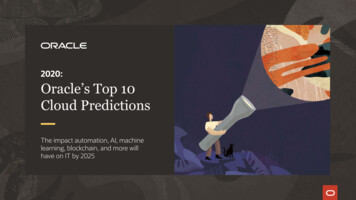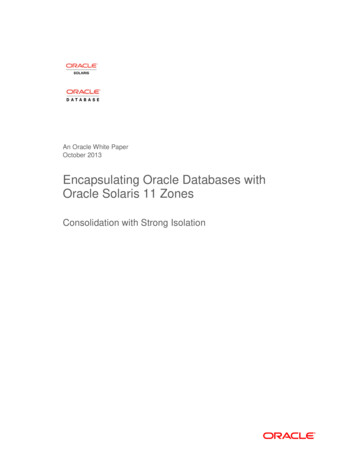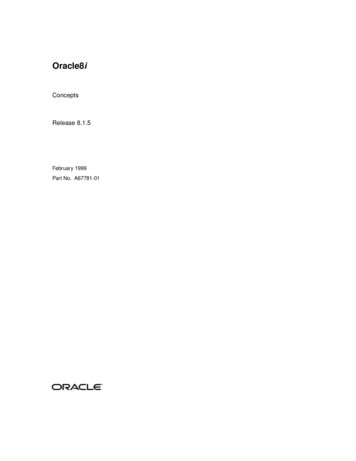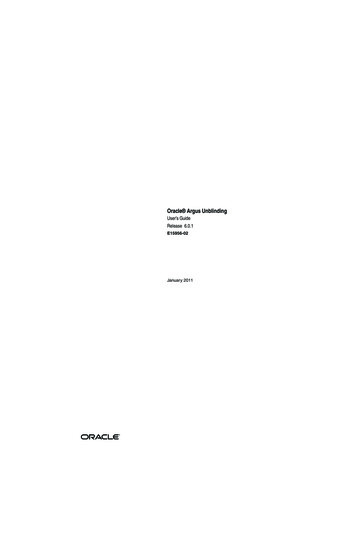
Transcription
2020:Oracle’s Top 10Cloud PredictionsThe impact automation, AI, machinelearning, blockchain, and more willhave on IT by 2025
ContentsIntroduction12345PredictionNumber 1PredictionNumber 2PredictionNumber 3PredictionNumber 4PredictionNumber 590 percent of all manual IT operationsand data-management tasks will be completely automated, opening thedoor to a new era of IT innovation.There will be 600 times more sensitivedata shared in the cloud.100 percent of enterprise applicationswill include some form of AI.100 percent of supply-chain apps willdepend on augmented reality, virtualreality, blockchain, ML, and IoT.Automated business processeswill enable more personalizedinteractions in HR, sales, andother business domains.Learn moreLearn moreLearn more678Learn moreLearn more910PredictionNumber 6PredictionNumber 7PredictionNumber 8PredictionNumber 9PredictionNumber 1080 percent of major cities will useIoT for Smart City initiatives.Data science will be increasinglyautomated and embedded into analyticsand data-management systems.The rise of AI-based machines willcreate new jobs that haven’t beeninvented yet.Cybersecurity attacks will becomemore sophisticated with the useof IoT and AI.80 percent of data will be linkedto things instead of individuals.Learn moreLearn moreLearn moreLearn moreConclusionLearn more
3Preparing for the nextgeneration of the cloudWhy is cloud computing such a game changer?efficiency, and security. Forward-looking customersIn a word, immediacy. Cloud models enable real-timeare drawn to these next-generation clouds for threeviews into your data, opening the door to instantaneousprimary reasons:insights. It’s no wonder that 74 percent of businessessay the cloud has given them a competitive edge.1However, not all clouds are created equal. Firstgeneration infrastructure-as-a-service (IaaS) andplatform-as-a-service (PaaS) clouds were built usingdecades-old technology. Newer, second-generationclouds have been designed to support the technologiesthat drive the modern enterprise (such as AI, blockchain,Internet of Things (IoT), and real-time analytics) aswell as to meet today’s relentless demands for scale,To accelerate agility: 70 percent of ITdecision-makers believe cloud computingmakes them more agile.2To scale more easily: Companies that adoptcloud services experience a 20.6 percentaverage improvement in time to market.3To get online fast: 49 percent of enterprisessee faster time to deployment as a key reasonfor migrating to a modern cloud.41RedNight, “Cloud Computing: The Best Benefits of Comprehensive Professional Services,” January 9, 2018, enefits/.2Oracle webpage, roadtothe.cloud/uae.3Vanson Bourne, State of IT Report, 20184Forrester, “Global Business Technographics Infrastructure Survey,” 2018By 2025, Oracle expects to see moreand more enterprises embrace a nextgeneration cloud model to achieveunprecedented degrees of automation.In this installment of our “Top 10 CloudPredictions,” we explore what theseclouds will look like, explain how theywill shape tomorrow’s IT environments,and delve into the technologies andbusiness models that are changing theface of enterprise computing.
Prediction #190 percent of all manualIT operations and datamanagement tasks willbe completely automated,opening the door to a newera of IT innovation.
5Prediction #1While some technology professionals are still consumedFor example, self-learning systems automate thewith routine operations such as backing up, scaling,collection of data across multiple applications, andtuning, monitoring, and securing critical informationcan automatically visualize millions of data points.systems, autonomous databases are quickly makingBy displaying enterprise data through graphs, charts,these activities a thing of the past. By 2025, 90 percentand animations, business users can more easilyof all manual IT operations and data-management tasksperceive trends, patterns, and correlations in their data,will be completely automated.rather than trying to glean insights from columnarAs IT professionals shed a progressively larger portionadvanced technologies into the mainstream.of these administrative tasks, they will have more timeto develop analytic applications and bring new revenueproducing products and services to market. Cloudcomputing enables organizations to innovate fasterthan ever before. Liberated IT workers have more timeto explore the latest advancements in AI and machinelearning (ML)—from conversational user interfaces toblockchain to the IoT.reports and spreadsheets. The cloud moves theseBy 2025, 90 percentof all manual IToperations and datamanagement taskswill be completelyautomated.
Prediction #2There will be 600 timesmore sensitive data sharedin the cloud.
7Prediction #2The attackers arebecoming moresophisticated,so it’s critical forcompanies to ensurethe resilience of theirdata and systems.Seven out of ten organizations now keep business-The attackers are becoming more sophisticated, socritical data in the cloud. Most of these organizationsit’s critical for companies to ensure the resilience ofdepend on hybrid clouds that allow them to keep sometheir data and systems. However, due to a significantcritical business systems on premise and shift most ofshortage of cybersecurity expertise, it will be evertheir data into the cloud. While this approach maximizesharder for companies to hire enough people to staffflexibility and reduces cost, it also exposes organizationstheir security operations. Unpatched systems createto increased risk, because hybrid environments canan easy path for attackers who are intent on targetinglead to inconsistent security policies and controls.known vulnerabilities. To prevent new cyberattacks,By 2025, there will be 600 times more sensitive dataorganizations need autonomous systems that infuseshared in the cloud and a corresponding increase inadvanced security capabilities into every layer of the ITsecurity threats, both from automated external attacksinfrastructure—from the applications, to the data, downand the misuse of authorized identity credentials.into the silicon.
Prediction #3100 percent of enterpriseapplications will includesome form of AI.
9Prediction #3AI technology is fundamentally altering enterprisehumans, both externally with customers and internallycomputing by changing how organizations receive,in the workplace. For example, in finance, machinesmanage, and secure business data. Enterprises arewill field queries about invoices, POs, expenses, andquickly embracing AI as they perceive its ability tobudgets, enabling a new level of self-service. Real-improve efficiency, boost productivity, and reduce costs.time financial reporting will make traditional reportingBy 2025, 100 percent of enterprise applications willcycles less relevant, eliminating the need for monthlyinclude some form of embedded AI. These technologyor quarterly analysis. These real-time data processingadvancements will impact all parts of the business,models will impact not just finance, but many otheraccelerating time to insight by helping managers andbusiness domains as well. As information becomesexecutives obtain a better understanding of operations,instantly available, organizations will be able to focus onemployees, markets, and customers.discovering actionable insights that drive the businessML capabilities allow information systems to getever smarter as they interact with more people andsystems. Conversational AI is creating a new standardof engagement between automated robots andforward, instead of merely processing data.By 2025, 100percent of enterpriseapplications willinclude some formof embedded AI.
Prediction #4100 percent of supplychain apps will depend onaugmented reality, virtualreality, blockchain, ML,and IoT.
11Prediction #4Intelligent automated systems are quickly taking holdassistants can look up product information and reportin many industries, causing paradigm shifts in systemproduction milestones, conveying insights aboutdesign, logistics, manufacturing, infrastructure, andcurrent conditions gleaned from IoT sensors.more. Increased buyer expectations, shorter productIn some cases, AIalgorithms eliminatethe need for humandecision-makingaltogether.lifecycles, new regulations, and fluctuating demands aretesting the limits of traditional supply chains and drivingthe adoption of emerging technologies. For example,in manufacturing, self-learning techniques and naturallanguage processing (NLP) technologies help automatedemand forecasting, predictive maintenance, andfulfillment. In some cases, AI algorithms eliminate theneed for human decision-making altogether. Virtualreality (VR) and augmented reality (AR) interfacesenable more-immersive experiences for employees,such as 3D renderings that help shop-floor workersvisualize equipment configurations. Voice-controlledBlockchain solves major challenges in these supplychains by curtailing counterfeiting and improvingvisibility/traceability. Materials and products thattravel globally must pass through multiple suppliers,manufacturers, distributors, carriers, and serviceproviders. Blockchain deregulates global supply chainsthat formerly relied on centralized governance models,creating decentralized, distributed, and digital recordsof transactions that are anonymous, tamper-proof, andunchangeable.
Prediction #5Automated businessprocesses will enable morepersonalized interactionsin HR, sales, and otherbusiness domains.
13Prediction #5AI and autonomous technologies are permeating theIn sales, AI systems can analyze large datasets toworkplace, streamlining routine business processes andidentify the leads that are most likely to lead to sales.freeing up professionals to focus on more-meaningfulAI systems compile vast amounts of client data, fromand productive human interactions. For example,social-media postings to customer interaction historiesautomated workflows can streamline recruitingto sales and service events. AI’s self-learning capabilitiesoperations by tracking applicants and fielding requestsenable software processes to interact with lots offrom new hires. Some HR teams use AI to identify toppeople simultaneously while conveying consistentcandidates by comparing their stated qualificationsbrand messages. Software bots can qualify leads, rankagainst job postings. Chatbots can communicateopportunities, and deliver targeted recommendationswith candidates to answer questions and scheduleto prospective clients. They can adjust pricing andinterviews. These automated functions alleviate routinerecommend products based on market-basketadministrative tasks so HR professionals can focus onanalysis and browsing history. While the heart of saleshiring qualified candidates that match the corporatewill always be human interaction, the value of theseculture. By 2025, 70 percent of recruiting will be takenintelligent technologies will continue to grow. By 2025,over by AI and bots.80 percent of sales will be automated, enabling salesreps to focus on relationship-building and customerengagement.By 2025, 80 percent ofsales will be automatedenabling sales reps tofocus on relationshipbuilding and customerengagement.
Prediction #680 percent of majorcities will use IoT forSmart City initiatives.
15Prediction #6By 2025, 80 percentof major cities will useIoT data for Smart Cityinitiatives.The growth of IoT technologies is enabling communitiesOver the long term, IoT technology will improveto become more human-centric and resilient. By 2025,collaboration and trust amongst citizens to create80 percent of major cities will use IoT data for Smartmore-unified cities. As these technologies becomeCity initiatives. At the core of these endeavors, MLmore affordable and ubiquitous, many communitiestechnology will be used to gather and analyze citywill deploy intelligent resources such as fixed videodata and increase citizen engagement. Automatingsurveillance and officer wearables, further improvingroutine interactions will free up human agents to offersafety and transparency. Other popular Smart Citypersonalized services. These technologies will improveinitiatives include resilient energy and intelligentaccountability by requiring city leaders to become moretransportation. The applications are virtually endless,transparent in their dealings—decentralizing data,and each use case serves to improve the quality of lifetechnologies, and decision-making.for these communities.
Prediction #7Data science will beincreasingly automatedand embedded intoanalytics and datamanagement systems.
17Prediction #7Data scientists help convert massive amounts of dataFortunately, as AI and ML technologies become moreinto actionable insights, leveraging unique skills insophisticated, they will automate a progressively largeradvanced math and statistics, as well as ML and AI.portion of today’s data science tasks, making eachAs organizations continue to discover the value of data-skilled worker more efficient. For example, today’sdriven insights, the demand for data scientists will grow.data scientists typically spend 80 percent of theirThe industry is already seeing a deficit in these skilledtime collecting and preparing data, and only aboutworkers and, by 2025, based on current trajectories,20 percent of their time looking for patterns in that datathere will not be enough data scientists to meetand discovering new insights.5 As augmented analyticrising demand.systems get powerful enough to train and executealgorithms at scale, the vast majority of today’s datacollection and preparation tasks will be automated. AIsystems will also get better at generating insights andinterpreting results for business users, freeing up datascientists to determine which findings are most relevantout of all the potential outcomes.5Gil Press, Forbes, “Cleaning Big Data: Most Time-Consuming, Least Enjoyable Data Science Task, Survey Says” (March 23, 2016)By 2025, based oncurrent trajectories,there will not beenough data scientiststo meet rising demand
Prediction #8The rise of AI-basedmachines will createnew jobs that haven’tbeen invented yet.
19Prediction #8Machines are actingas employees in somecompanies, requiringbusiness leaders toconsider how thesemechanical workerscan best collaboratewith one another.AI is becoming a critical part of the corporate workforceWhile the rise of automation will displace someas more and more machines use the technologymanual and repetitive tasks, the prevalence of AI isto interact with humans. Machines are acting assimultaneously creating many new and compellingemployees in some companies, requiring businessopportunities. By 2025, it will create thousands ofleaders to consider how these mechanical workersnew roles, including many jobs that haven’t beencan best collaborate with one another. For example,invented yet. In that time, machines will perform doublein manufacturing, AI-driven robots can autonomouslythe amount of work as humans. While the rise oflocate and store products in a warehouse. Usingautomation may stir fear for the immediate workforce,vision sensors, driverless vehicles can assess theirover the long term it will enable a more prosperousenvironments and react to changing conditions.economy, higher-value work, and a better quality ofOnboard systems use mathematical models to avoidlife across the globe.obstacles, establish optimal routes, and increase theefficiency of packing and picking processes. On roadsand highways, autonomous vehicles use AI-basedsystems to connect and communicate with each other,as well as with the infrastructure around them.
Prediction #9Cybersecurity attackswill become moresophisticated with theuse of IoT and AI.
21Prediction #9As useful as ML technologies are to businessBy 2025, 80 percent of security attacks will come fromoperations, in the wrong hands they can turn thesean inside source. Security misconfigurations can occurtechnologies against us. Cybercriminals can useat any layer of the technology stack, from networkautomated AI and IoT systems to breach enterpriseservices to the database, and attackers will often exploitnetworks and steal sensitive data. As smart devicesthese vulnerabilities to breach information systems.store progressively more personal information, theyIn many cases, security patches are not installed quicklybecome new targets for these attackers. Maliciousenough, creating an easy path for attackers who targetIoT programs can infect connected devices andthese known vulnerabilities. Lack of automation alsoaid criminals in stealing identities or committing aintroduces a high risk of human error. Automateddistributed denial of service (DDoS) attack. Accordingcybersecurity processes can detect misconfigurationsto Forrester, the rapid adoption of IoT is creating a largerand provide continuous protection. The most reliableattack surface that’s often built with only a few securityway to combat these growing threats is by usingcontrols, exposing enterprises in never-before-seenautonomous technologies that can automaticallyways.6 Similarly, as businesses and individuals increaseapply patches and validate system integrity 24/7.their reliance on cloud-based storage, attackers willhave a wider surface area to target.6PREDICTIONS 2020: On the Precipice of Far-Reaching Change (Forrester, December 2019).By 2025, 80 percentof security attackswill come from aninside source.
Prediction #1080 percent of data willbe linked to thingsinstead of individuals.
23Prediction #10In the years ahead, the majority of security threatsBy 2025, 80 percent of identity will be the identity ofwill involve Internet-connected things. For example,things rather than of individuals. The scale of identityForrester predicts that cyberattackers will blockdata is larger than ever before, with much of that dataconnections to products such as home lightingscattered across users, applications, and ecosystems.systems, or meddle with the operation of critical shop-Context-based identity correlates relevant data withfloor machinery—and “hold these devices hostage”these identities such as behavior data, location data,until the manufacturer pays a large ransom.7usage patterns, systems information, and more. Bylinking additional data with an identity, cybersecurityprofessionals—bolstered by ML and AI—canpredict behaviors and patterns that reveal potentialsecurity threats. Using ML and predictive analytics,organizations will increase visibility into their systemsto autonomously identify suspicious activity on anunprecedented scale.7PREDICTIONS 2020: On the Precipice of Far-Reaching Change (Forrester, December 2019).The scale of identitydata is larger than everbefore, with much of thatdata scattered acrossusers, applications,and ecosystems.
24ConclusionToday, it is imperative for companies of all sizes andOracle’s second-generation offering is built on thegeographies to adopt a next-generation cloud—a cloudworld’s most robust cloud infrastructure, poweredthat is designed for the modern enterprise, and thatby integrated platform services and a comprehensiveyields unprecedented scale, efficiency, and security.software portfolio—from application developmentHow do you get there?Oracle is leading the way with a second-generationcloud that fundamentally rearchitects conventionalIaaS and PaaS cloud offerings. Built from the groundup to meet the needs of mission-critical applications,Oracle Cloud features the world’s first self-repairing,self-tuning, self-driving Oracle Autonomous Database,in conjunction with the advanced analytics capabilitiesof Oracle Analytics Cloud. These mature cloud servicesand business analytics to data management, integration,Learn moreand get startedOracle Cloud Infrastructuresecurity, AI, and blockchain—so you can instantly utilizethe technologies that drive market leaders to succeed.Oracle Autonomous DatabaseIt also includes robust planning, validation, andmigration tools to orchestrate the movement of youron-premise information systems to the cloud. You’llgain the ability to more easily mitigate security threatsDo more with dataand automate data-management tasks, all withindustry-leading scalability, availability, and performance.eliminate complexity, human error, and manualmanagement, all while cutting administration costsby up to 80 percent.Copyright 2020, Oracle and/or its affiliates. All rights reserved. This document is provided for information purposes only, and the contents hereof are subject to change without notice. This documentis not warranted to be error-free, nor subject to any other warranties or conditions, whether expressed orally or implied in law, including implied warranties and conditions of merchantability or fitness fora particular purpose. We specifically disclaim any liability with respect to this document, and no contractual obligations are formed either directly or indirectly by this document. This document may notbe reproduced or transmitted in any form or by any means, electronic or mechanical, for any purpose, without our prior written permission. Oracle and Java are registered trademarks of Oracle and/ or itsaffiliates. Other names may be trademarks of their respective owners. VDL51082 200114Tips for IT and Business leaders
90 percent of all manual IT operations and data-management tasks will be complete-ly automated, opening the door to a new era of IT innovation. Prediction Number 6 80 percent of major cities will use IoT for Smart City initiatives. Prediction Number 2 There will be 600 times more sensitive data shared in the cloud. Prediction Number 7











